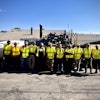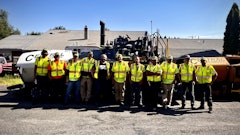Decades in the making, the Occupational Safety and Health Administration (OSHA) released a proposed permissible exposure level (PEL) for silica dust. The proposed level is more stringent than the agency’s current regulations, but thanks to the work of the Silica/Milling Machine Partnership the asphalt industry is positioned to meet the new standard.
The proposed PEL for silica dust is now set at 50 micrograms of respirable crystalline silica per cubic meter of air (50 μg/m3). This is consistent with the National Institute for Occupational Safety and Health’s (NIOSH) current recommended exposure level (REL) for silica, and will provide greater protection for those who work with materials that cause silica exposure. Silica, a known carcinogen, is also known to cause silicosis, a restrictive lung disease.
For the asphalt pavement industry, dust from roadway milling operations is the greatest potential source of silica exposure for workers. Steps to mitigate this hazard have been well documented, and current milling-machine technology can ensure exposure levels below the current OSHA standard.
Over the past decade, the Silica/Milling Machine Partnership — which is made up of the National Asphalt Pavement Association (NAPA), milling-machine manufacturers, labor, academia, and NIOSH — has worked to identify simple retrofits for existing milling machines that effectively reduce potential silica exposure below OSHA’s new proposed PEL. More advanced systems that could reduce dust and potential silica exposure even further have also been studied.
“The Partnership is committed to doing the best work possible to ensure that workers are safe and that any silica exposure is reduced to the absolutely lowest level possible,” said Tony Bodway, Operations Manager for Wisconsin-based contractor Payne & Dolan Inc. and Chairman of the Silica/Milling Machine Partnership. “These are complicated field trials, with lots of coordination and effort, all while working alongside government occupational health agency personnel. Everyone involved has been focused on ensuring we do our best.”
While the proposed PEL is achievable, as part of the federal rulemaking process, NAPA will file comments offering suggestions to help better calibrate the rule to the industry’s exposure potential.
NIOSH is expected to release in the coming months a best practices document for roadway milling based on the work of the Silica/Milling Machine Partnership. This document will provide a simple roadmap to ensure that any dust generated during milling operations is well-controlled during milling operations is well-controlled and that workers experience a safe workplace.
Asphalt Industry Positioned to Meet OSHA’s Proposed Silica Standard Rule
NIOSH is expected to release in the coming months a best practices document for roadway milling based on the work of the Silica/Milling Machine Partnership.
Aug 26, 2013
Latest in Business
Rethinking Leadership In The Asphalt Industry
December 28, 2025
DEVELON to Debut Next-Generation Excavators at CONEXPO-CON/AGG 2026
December 27, 2025


















